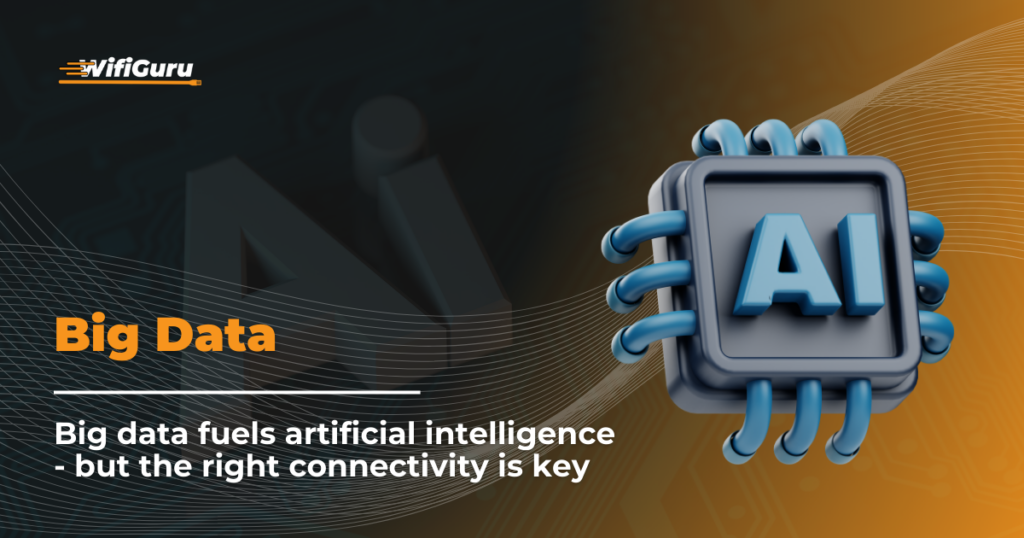
In today’s digital age, the synergy between big data and artificial intelligence (AI) is revolutionizing industries across the globe. However, while AI thrives on vast amounts of data, the backbone of this relationship is often overlooked: reliable and high-speed connectivity. Without the right internet infrastructure, the potential of AI remains untapped, and the benefits of big data can go unrealized. In this blog, we delve into how big data fuels AI and why robust connectivity is crucial for harnessing its full potential.
The Interplay Between Big Data and AI
AI systems learn and improve through data. The more data these systems access, the better they become at identifying patterns, making predictions, and automating tasks. Big data, characterized by its volume, velocity, and variety, provides the rich datasets AI needs to perform these complex analyses.
- Volume: AI algorithms need large datasets to learn from, which big data provides in abundance. These vast quantities of data help AI models to be more accurate and effective.
- Velocity: The speed at which data is generated and processed is crucial. Real-time data streaming allows AI systems to make timely decisions, which is essential in applications like autonomous driving and financial trading.
- Variety: AI systems benefit from diverse data types, such as text, images, and videos. Big data encompasses this variety, enabling AI to develop more comprehensive and nuanced insights.
Why Connectivity Matters
For AI and big data to function optimally, a robust and reliable internet connection is non-negotiable. Here’s why:
- Data Transmission: The transfer of large datasets across networks requires high-speed connectivity. Slow or unstable connections can hinder the movement of data, causing delays in AI processing and decision-making.
- Cloud Computing: Many AI applications leverage cloud-based platforms for storage and computation. High-quality connectivity ensures seamless access to these cloud resources, enabling efficient data processing and model training.
- Real-time Analytics: For AI systems to provide real-time insights, such as in predictive maintenance or customer behavior analysis, they need immediate access to data. Low latency connections are essential to avoid lags and ensure timely responses.
- IoT Integration: The Internet of Things (IoT) generates vast amounts of data from connected devices. Reliable connectivity is crucial for aggregating this data and feeding it into AI systems for analysis.
Case Studies Highlighting the Importance of Connectivity
- Smart Cities: In smart cities, AI-driven systems manage traffic flow, energy usage, and public safety. These systems rely on real-time data from various sensors and devices. Without robust connectivity, the data flow would be disrupted, leading to inefficiencies and potential safety risks.
- Healthcare: AI in healthcare helps in diagnostics, personalized treatment plans, and predictive analytics. High-speed internet is critical for transferring large medical datasets and real-time monitoring, ensuring that healthcare providers can make timely and informed decisions.
- Autonomous Vehicles: Autonomous vehicles depend on AI for navigation and decision-making. They continuously send and receive data from the cloud to update their algorithms. A stable and fast internet connection is vital to ensure the safety and reliability of these vehicles.
Future-proofing with Advanced Connectivity Solutions
To fully leverage the power of big data and AI, investing in advanced connectivity solutions is essential. Here are some ways to future-proof your infrastructure:
- Fiber-optic Networks: Fiber-optic cables offer unmatched speed and reliability, making them ideal for data-intensive applications. Investing in fiber-optic networks ensures high-speed data transmission with minimal latency.
- 5G Technology: The rollout of 5G promises to revolutionize connectivity with its high speed and low latency. 5G networks will support the massive data transfer needs of AI applications and enable real-time analytics and IoT integration.
- Edge Computing: By processing data closer to the source, edge computing reduces latency and bandwidth usage. This approach is particularly beneficial for applications requiring real-time data processing, such as autonomous vehicles and industrial automation.
- Network Redundancy: Building redundant networks ensures continuous connectivity even in the event of a failure. Redundant paths and backup systems can prevent downtime and maintain seamless data flow.
Conclusion
The relationship between big data and AI is a powerful one, driving innovation and transforming industries. However, without the right connectivity, the true potential of this relationship cannot be realized. At Wifi Guru, we understand the critical role of robust internet infrastructure in supporting AI and big data initiatives. By providing high-speed, reliable connectivity, we enable businesses and communities to harness the power of AI, drive efficiencies, and create a smarter, more connected future.
Invest in the right connectivity solutions today to unlock the full potential of big data and AI. With Wifi Guru, you’re not just getting an internet connection; you’re getting a partner committed to your success in the digital age.